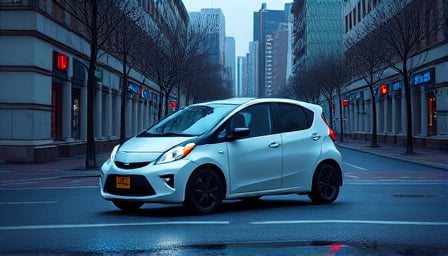Tesla’s Robotaxi Ambitions: A Bold Move Amid Financial Struggles
In a world where innovation and disruption are the currencies of success, Tesla’s latest venture into the autonomous vehicle market is both a daring gamble and a potential game-changer. Elon Musk, the enigmatic CEO, has announced Tesla’s plan to launch its robotaxi service in Austin, Texas, by June 2025. This move comes at a time when Tesla is grappling with financial challenges, raising questions about the timing and strategic implications of this ambitious project.
Financial Turbulence and Strategic Shifts
Tesla’s recent financial performance has been less than stellar. The company reported a first-quarter revenue of $19.34 billion, falling short of Wall Street’s expectations of $21.43 billion. This decline is significant compared to the $21.3 billion posted in the same period of 2023. Adjusted earnings per share were a mere $0.27, missing the consensus estimate of $0.44. Musk has attributed part of these struggles to his involvement in government affairs, particularly his role in former President Donald Trump’s administration. Starting in May, Musk plans to reduce his time in these duties to refocus on Tesla.
The Robotaxi Rollout
Despite these financial headwinds, Tesla is pushing forward with its robotaxi initiative. The initial rollout in Austin will feature 10 to 20 Model Y vehicles equipped with Tesla’s “Full Self-Driving” software. While this technology currently operates under human supervision, Musk has emphasized plans for rapid expansion to other U.S. markets later in the year. This move is not just about launching a new service; it’s about validating Tesla’s autonomous driving technology on a commercial scale.
In parallel, Tesla is developing the “Cybercab,” a purpose-built autonomous vehicle without a steering wheel or pedals. Production is anticipated to begin in 2026 at Tesla’s Gigafactory in Texas, with the vehicle priced under $30,000. The Cybercab aims to revolutionize the ride-hailing industry with its “unboxed” manufacturing process, promising to produce one unit every five seconds.
Internal Testing and Regulatory Hurdles
Tesla has already initiated internal testing of its FSD Supervised ride-hailing service with employees in Austin and the San Francisco Bay Area. Over 1,500 trips and 15,000 miles have been logged, providing valuable data to refine the technology and operational logistics. However, regulatory approval remains a significant challenge. The success of Tesla’s robotaxi service hinges not only on technological advancements but also on navigating the complex landscape of government regulations.
Crypto Currency Robotaxi: A Financial Perspective
Amid these developments, the crypto currency Robotaxi has seen its close price drop to 0.0082587 as of April 23, 2025, from a 52-week high of 0.0317661 on February 18, 2025, and a low of 0.00056898 on November 1, 2024. This volatility reflects the broader uncertainties in the crypto market, which could be influenced by Tesla’s ambitious plans and the potential impact on the automotive and tech industries.
Conclusion
Tesla’s foray into the robotaxi market is a bold move that could redefine the future of transportation. However, it comes at a time when the company is facing significant financial and operational challenges. As Musk refocuses his efforts on Tesla, the success of this venture will depend on overcoming technological hurdles, securing regulatory approval, and navigating the volatile crypto market. The stakes are high, and the world is watching.
